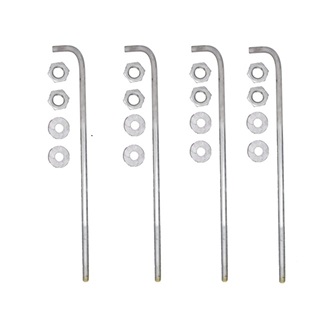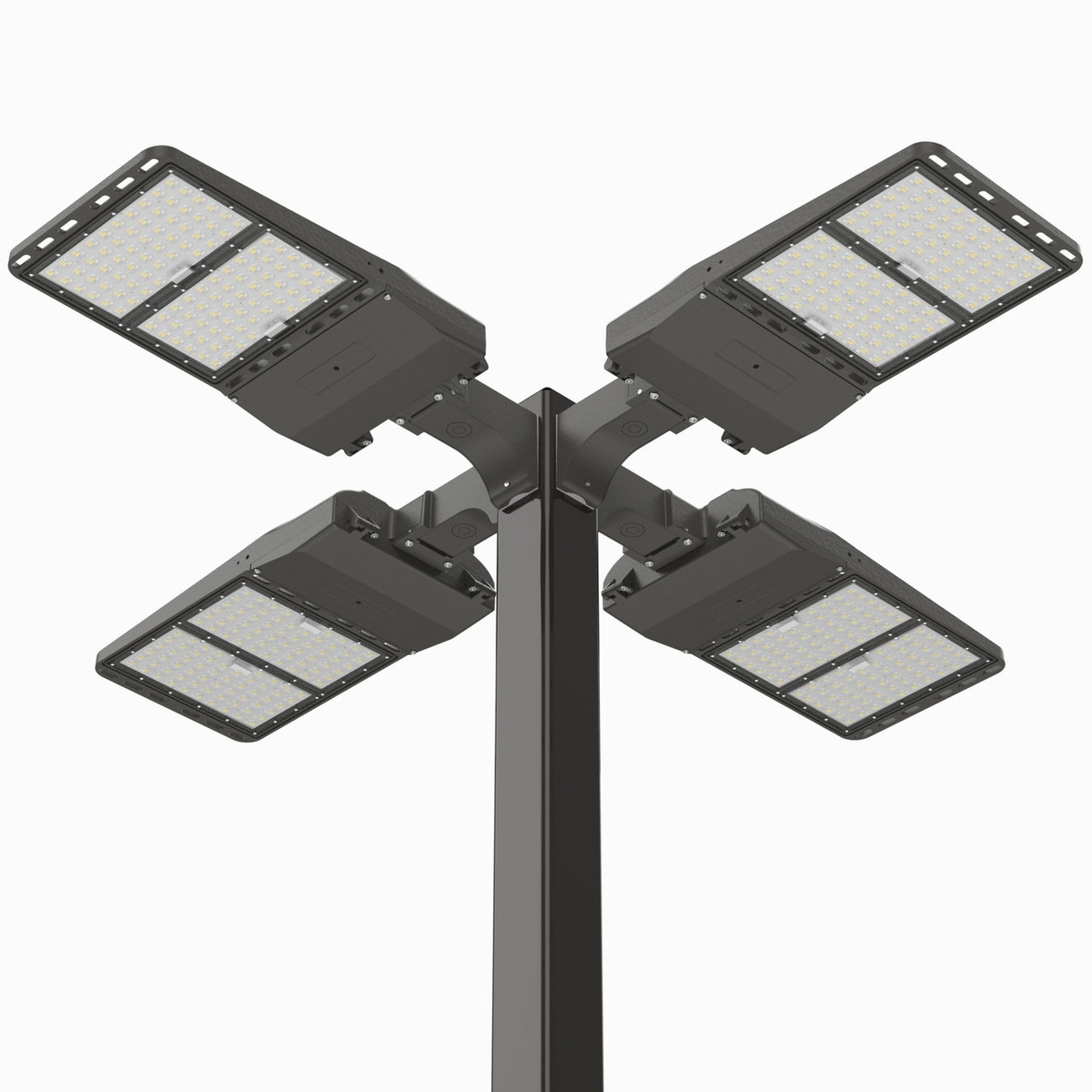There are several options to choose from when deciding which materials will be used during the light pole manufacturing process.
These materials will determine some very important factors about the light poles that are produced. Among those factors are:
- Their application (how they will be used)
- Their cost
- Their lifespan
- How they will be installed
- Their durability
Although some light poles are made of wood and concrete, we will focus this article on the three primary materials used in their construction: steel, aluminum, and fiberglass.
Steel

Steel is the most common material used for light poles. When manufacturing a steel light pole, a flat steel sheet is cut to the desired width and length, and then a tube is formed by cold rolling or pressed on a brake.
Steel properties:
- Very strong material
- Flexible design
- Cost-effective
Benefits
- Steel poles are very strong. They can handle high winds and support multiple attached fixtures.
- Steel poles can be powder-coated and/or galvanized. This adds to their lifespan by protecting them against rust and corrosion.
- Steel is an economical choice for large-scale projects.
LightMart offers steel light poles in a variety of styles. These include:
- Round, round tapered, square, and square tapered shapes.
- 10- to 60-foot pole heights (custom heights available)
- Specialty items such as hinged, hurricane-resistant, and heavy-duty poles
- 7- or 11-gauge thickness options
- Multiple color options
Aluminum

Aluminum light poles are manufactured by using molten aluminum to form the poles. It is put into a mold that matches the specifications of the light pole shaft. Aluminum is very malleable which means that it can be formed into a wide variety of shapes and sizes by extrusion.
Aluminum properties:
- Lightweight
- Corrosion resistant
- Aesthetically appealing
Benefits
- Durable and long-lasting
- Their lightweight nature makes them easy to install.
- Resistant to corrosion and rust. Because of this, they can be installed near coastal areas where corrosion is a consideration.
- Their long lifespan (50+ years) makes them a good long-term investment.
- They can be powder-coated or anodized for extra protection.
- Anodized aluminum poles come in a wide variety of colors.
LightMart offers aluminum light poles in a variety of styles. These include:
- Direct burial or anchor base installation types.
- Round, round tapered, and square shapes.
- 6- to 25-foot pole heights (custom heights available)
- Specialty items such as hinged base, transformer base, and hurricane resistant.
- Multiple color options
Fiberglass

Fiberglass poles have two primary components: fiberglass and resin. Fiberglass cords are produced using fiberglass strands that are wound together. These cords are dipped into a polyester resin bath. They are then wrapped around a mandril. The pole is then powder-coated or painted.
Fiberglass Properties:
- Non-conductive
- Corrosion resistant
- Lightweight
Benefits
They are corrosion resistant which makes them ideal for coastal areas.
- Easy to install (lightweight).
- Safety benefits (non-conductivity)
- Aesthetic flexibility (can be molded)
- Resistant to harmonic vibration.
LightMart offers fiberglass light poles in a variety of styles. These include:
- Round tapered and square shapes.
- Direct burial or anchor base installation types.
- 10- to 30-foot pole heights (custom heights available)
- Multiple color options
Materials for light pole components
The shaft is not the only part of a light pole. There are other components as well and they are not always made from the same material as the shaft.
- Anchor bolts, nuts, and washers
- Anchor bolts, nuts, and washers are used to secure anchor base poles to their foundations. These components are always made from galvanized steel regardless of the material used to make the pole shaft.

- Top caps:
- For steel poles, the tops are made from plastic, and their fastening clips are made from steel.
- For aluminum and fiberglass poles, the tops are made from cast aluminum.

- Base covers:
- For steel poles, the base covers are made from ABS plastic, thin steel, or aluminum.
- For aluminum and fiberglass poles, the base covers are made from ABS plastic or aluminum.

- Hand hole covers:
- For steel poles, the hand hole covers are made from plastic, steel, or aluminum.
- For aluminum and fiberglass poles, the hand hole covers are made from plastic or aluminum.

- Mounting brackets used for mounting light fixtures, etc., are typically made from steel or aluminum.

Comparison of steel, aluminum, and fiberglass
Durability
- Steel poles are strong but are more susceptible to rust and corrosion than aluminum and fiberglass poles. This is why they don’t have as long of a lifespan and have higher maintenance costs. However, their strength allows them to handle heavy loads on top of them.
- Fiberglass poles last longer than steel but not as long as aluminum. Typically, around 20 to 30 years.
- Aluminum poles have a long lifespan of 50+ years, which is longer than all other types of poles. This means that they don’t have to be replaced as often.
Cost
Steel light poles are the cheapest, and most cost-effective of the three types. Aluminum light poles are cheaper than fiberglass light poles. They last longer than fiberglass poles but are not as lightweight, are not non-conductive, and they’re not resistant to harmonic vibration. That is the trade-off between the two.
Maintenance
- Steel poles require more maintenance than aluminum and fiberglass poles due to their greater susceptibility to rust and corrosion.
- If the pole is powder coated, mineral spirits can safely be used to clean off dirt, grease, and graffiti.
- If the pole is made of galvanized steel or has a natural aluminum finish, use 600-grit sandpaper. Power washing is also recommended.
- If the pole is made of anodized aluminum, use 600 (or more) grit sandpaper.
- Repainting is required as needed. Oil-based paint is recommended for powder-coated poles.
- Rust inhibitor and naval jelly can also be used as needed for steel poles.
For more information, see our light pole maintenance article here.
Conclusion
It’s important to choose the right light pole material based on specific needs and environmental conditions.
For example, aluminum and fiberglass light poles should be used for:
- Direct burial light pole applications. This is because a section of the pole is below ground and these materials are better able to handle the conditions.
- Coastal areas where salt water or salt spray is present.
Another example would be street light poles that are installed on a bridge or overpass. In this case, the best street light pole material would be fiberglass due to its resistance to harmonic vibration.
Looking for a Light Pole Partner?
LightMart has expertise and a wide range of offerings in the light pole industry. We provide factory-direct light poles for many applications, including parking lots, roadways, outdoor sports venues, auto dealerships, and more! Contact us today!
David DeWald is the E-Commerce Marketing Specialist at LightMart. He has been working in the industrial and commercial lighting industry since 2013 and is based in the greater Chicago area. David specializes in digital product management, web content writing, and product marketing. He regularly publishes lighting industry-related articles on the LightMart blog. You can visit his LinkedIn profile here.
